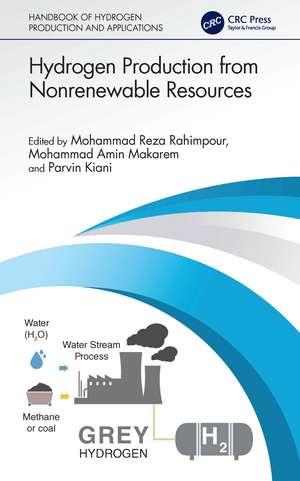Hydrogen Production from Nonrenewable Resources
Editat de Mohammad Reza Rahimpour, Mohammad Amin Makarem, Parvin Kianien Limba Engleză Hardback – 8 noi 2024
- Details of thermophysical characteristics and properties of hydrogen
- Covers conventional and novel industrial technologies for efficient production
- Explores environmental opportunities and challenges and health and safety regulations
- Provides techno‑economic and lifecycle assessments with future outlooks
Preț: 1009.28 lei
Preț vechi: 1230.83 lei
-18% Nou
Puncte Express: 1514
Preț estimativ în valută:
193.15€ • 200.91$ • 159.46£
193.15€ • 200.91$ • 159.46£
Carte tipărită la comandă
Livrare economică 14-28 aprilie
Preluare comenzi: 021 569.72.76
Specificații
ISBN-13: 9781032465586
ISBN-10: 1032465581
Pagini: 382
Ilustrații: 188
Dimensiuni: 156 x 234 mm
Greutate: 0.71 kg
Ediția:1
Editura: CRC Press
Colecția CRC Press
Locul publicării:Boca Raton, United States
ISBN-10: 1032465581
Pagini: 382
Ilustrații: 188
Dimensiuni: 156 x 234 mm
Greutate: 0.71 kg
Ediția:1
Editura: CRC Press
Colecția CRC Press
Locul publicării:Boca Raton, United States
Public țintă
PostgraduateNotă biografică
Mohammad Reza Rahimpour is a Distinguished Professor of Chemical Engineering at Shiraz University, Iran. He earned a PhD in chemical engineering at Shiraz University, in collaboration with the University of Sydney, Australia, in 1988. He leads a pioneering research group specializing in fuel processing technology, with a particular focus on the catalytic conversion of both fossil fuels, such as natural gas, and renewable fuels, like bio‑oils derived from lignin, into valuable energy sources. Throughout his academic career, Dr. Rahimpour has specialized in hydrogen production technologies, including steam methane reforming, water electrolysis, photocatalytic hydrogen production, and hydrogen production from both renewable sources and fossil fuels. His extensive expertise and innovative research significantly contribute to advancements in hydrogen production and its practical applications.
Mohammad Amin Makarem earned a PhD in chemical engineering at Shiraz University. His research interests include gas separation and purification, nanofluids, microfluidics, catalyst synthesis, reactor design, and green energy.
Parvin Kiani earned a degree in chemical engineering at Shiraz University. Her research has focused on gas separation, clean energy, and catalyst synthesis.
Mohammad Amin Makarem earned a PhD in chemical engineering at Shiraz University. His research interests include gas separation and purification, nanofluids, microfluidics, catalyst synthesis, reactor design, and green energy.
Parvin Kiani earned a degree in chemical engineering at Shiraz University. Her research has focused on gas separation, clean energy, and catalyst synthesis.
Cuprins
Section I: Hydrogen Properties and Characteristics. 1. Hydrogen Phase Equilibria and Solubility Data. 2. Combustion Characteristics of Hydrogen. Section II: Technologies for Conversion of Nonrenewable Sources to Hydrogen. 3. Steam Reforming Process for Conversion of Hydrocarbons to Hydrogen. 4. Autothermal Reforming Process for Conversion of Hydrocarbons to Hydrogen. 5. Dry Methane Reforming Process for Conversion of Hydrocarbons to Hydrogen. 6. Tri-Reforming Process for Conversion of Hydrocarbons to Hydrogen. 7. Catalytic-Membrane Reactor for Hydrogen Production from Hydrocarbons. 8. Plasma-Assisted Conversion of Hydrocarbons and Coal for Hydrogen Production. 9. Catalytic Decomposition of Hydrocarbons for Hydrogen Production. 10. Gasification and Pyrolysis of Plastic Wastes for Hydrogen Production. Section III: Challenges of Hydrogen Synthesis and Production. 11. Techno-Economic Assessments of Hydrogen Production Technologies. 12. Life Cycle Assessment of Hydrogen Production Techniques. 13. Role of Hydrogen in the Current World Energy Consumption and Future Trends.
Descriere
This book offers a comprehensive overview of hydrogen processing from nonrenewable sources, covering properties and characteristics of hydrogen, technologies for converting nonrenewable sources to hydrogen, and challenges.
